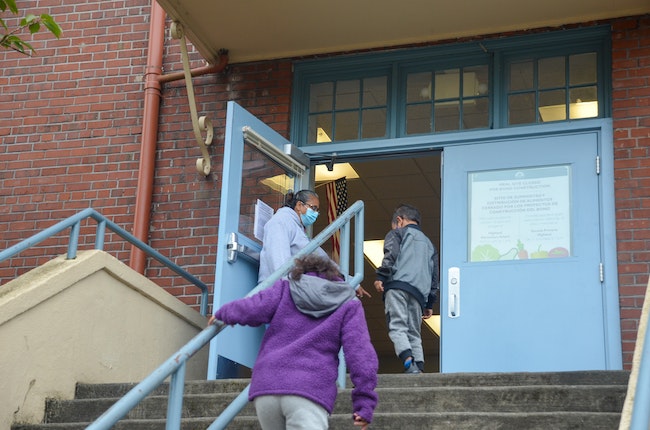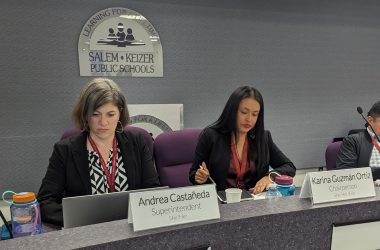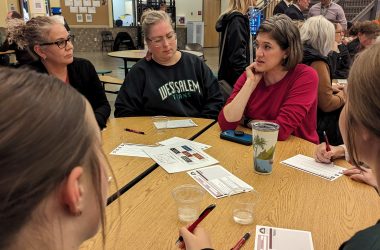
Highland Elementary School students enter the school library for brief in-person classes on Oct. 20, 2020 (Rachel Alexander/Salem Reporter)
A change to Oregon’s school reopening guidelines means tens of thousands more students could soon return to the classroom, but Salem students will see little change.
Gov. Kate Brown on Friday announced new standards designed to get more students back in school even as Covid cases and hospitalizations are rising across Oregon, saying data from other states that have reopened schools shows the risk of spreading the virus in schools can be managed through safety measures.
She said Covid is here to stay and the cost to students and working parents of continuing to keep so many schools closed is too high. Though many district remain ineligible to resume, Brown said the guidelines would allow an additional 130,000 students statewide back in the classroom.
“We must begin prioritizing getting our kids back into the classroom for in-person instruction,” she said in a news conference. “Too many of our students haven’t seen the middle of a classroom since March.”
But Marion County remains far from getting any advantage from even the relaxed targets, disappointing leaders of Oregon’s second-largest school district, who had hoped to bring more of the district’s youngest students back to classrooms.
“I had really high hopes this was going to impact how many kids we could get back … right away and it’s not,” said Kraig Sproles, assistant superintendent for the Salem-Keizer School District.
Oregon schools can now hold in-person classes for all elementary school students so long as they report no more than 100 new Covid cases per 100,000 county residents over a two-week period, with 8% or fewer of tests for the virus coming back positive.
Hitting that target would mean about 348 new Covid cases over two weeks for Marion County, and 86 for Polk County.
In-person classes could resume for all students with fewer than 50 cases per 100,000 residents over two weeks, and 5% or fewer tests positive. That’s 174 cases over two weeks in Marion County, or 43 in Polk.
Those numbers give districts much more leeway to resume in-person classes, but Marion County remains far from those targets, and numbers are moving in the wrong direction.
The county recorded 348 new Covid cases the week of Oct. 18, according to the latest Oregon Health Authority report tracking school reopening, with 8.8% of Covid tests positive. That’s double the number of cases allowed to resume elementary school classes, and four times the number to bring all students back in-person.
Polk County is within the target to resume elementary school, but that won’t matter for students in the Salem-Keizer School District attending school in west Salem. State guidelines say districts spanning multiple counties must be guided by numbers in the county hit hardest by Covid.
Sproles said even with high rates of Covid locally, he’s confident the safety protocols the district outlined over the summer would be effective. A handful of Salem elementary schools are holding short in-person sessions for students struggling with online classes.
The changes announced Friday will allow more students in schools for those brief sessions, a bright spot for the district. Students can now be in groups of up to 20, doubling the previous size limit, and there’s no longer a cap on the total number of students who can enter the same school building in one week.
Previously, the state capped that number at 250 students, making it challenging to offer help in small groups at some local high schools which have upwards of 2,000 students.
About 350 Salem-Keizer students were in school last week for an in-person session, according to state data, and Sproles said the district is moving forward with plans to expand those sessions to all district schools by mid-November.
The gradual expansion is to make sure safety protocols are effective before bringing too many kids into buildings.
“The last thing we want is to start it and have a large outbreak at several schools because that has happened in some districts,” Sproles said.
Still, staffing constraints make expanding small in-person groups difficult, Sproles said. The issue hasn’t been opposition from teachers, he said, many of whom want to be back in the classroom so long as safety precautions are followed.
But local schools don’t have a surplus of teachers available to help kids in-person while nearly all are running classes online, he said.
Those small groups don’t come close to helping every local student who has difficulty attending class online because of a language barrier, poor Internet connection at home or other challenges.
Sproles said that’s a primary concern for administrators and educators across the district, who anticipate a widening gap among students, particularly in elementary school, because of the disadvantages of on-line learning.
“For a student who can’t read, to be able to navigate learning in a totally digital environment is very difficult,” he said. “For those students in our community who don’t have a parent or an older sibling or a daycare provider who can sit side by side with them and help them navigate this digital environment, I am worried about the long-term impacts of keeping them out of school.”
This story was updated on Oct. 30 at 1:30 p.m.
SUPPORT ESSENTIAL REPORTING FOR SALEM – A subscription starts at $5 a month for around-the-clock access to stories and email alerts sent directly to you. Your support matters. Go HERE.
Contact reporter Rachel Alexander: [email protected] or 503-575-1241.

Rachel Alexander is Salem Reporter’s managing editor. She joined Salem Reporter when it was founded in 2018 and covers city news, education, nonprofits and a little bit of everything else. She’s been a journalist in Oregon and Washington for a decade. Outside of work, she’s a skater and board member with Salem’s Cherry City Roller Derby and can often be found with her nose buried in a book.









